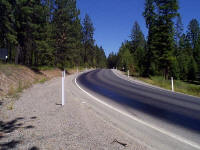Bleeding

Classic bleeding on a newly paved road shows up as a shiny reflecting surface – especially in the wheelpaths where the aggregate voids are less.

Bleeding on a freshly paved SMA job, most likely the result of mix design or production problems.
Problem
Loss of skid resistance when wet, unsightly
Possible Causes
Bleeding occurs when asphalt binder fills the aggregate voids during hot weather or traffic compaction, and then expands onto the pavement surface. Since bleeding is not reversible during cold weather or periods of low loading, asphalt binder will accumulate on the pavement surface over time. Likely causes are:
- Excessive asphalt binder in the HMA (either due to a poor mix design or manufacturing problems)
- Excessive application of asphalt binder during BST application
- Low HMA air void content (e.g., not enough void space for the asphalt to occupy), likely a mix design problem
Repair
The following repair measures may eliminate or reduce the asphalt binder film on the pavement’s surface but may not correct the underlying problem that caused the bleeding:
- Minor bleeding can often be corrected by applying coarse sand to blot up the excess asphalt binder.
- Major bleeding can be corrected by cutting off excess asphalt with a motor grader or removing it with a heater planer. If the resulting surface is excessively rough, resurfacing may be necessary (APAI, no date given).
Surface Distresses



